Appearance
Multithreading
开启新实验
git fetch
git checkout thread
make cleanUthread: switching between threads
任务描述:实现用户态多线程机制。(可以参考内核态中多线程的实现)
thread_switch需要在user/uthread_switch.S中实现,而user/uthread.c基本的框架已经完成,只需要完善两个函数的内容。
1. thread_switch
参考内核中swtch.S:
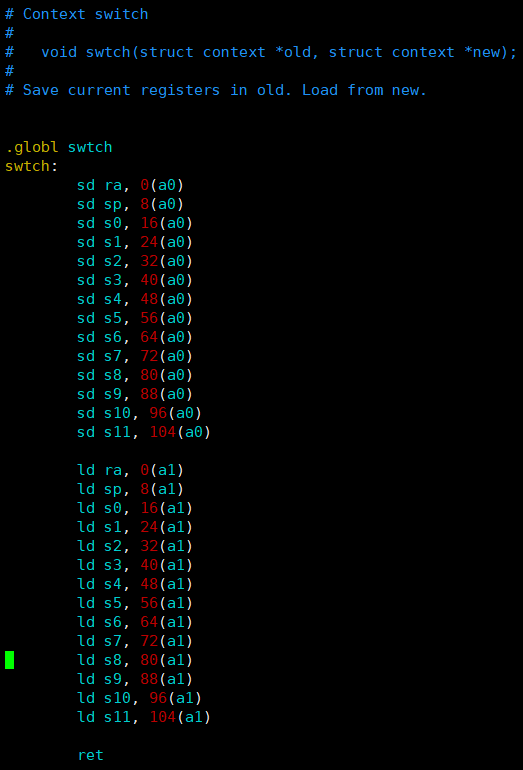
thread_switch和内核中的 swtch() 完全一样,用于切换处理器的上下文。
和内核中相同,因为执行这个函数的过程是一个正常的函数调用,所以不需要保存和交换调用者保存的寄存器。
.text
/*
* save the old thread's registers,
* restore the new thread's registers.
*/
.globl thread_switch
thread_switch:
/* YOUR CODE HERE */
sd ra, 0(a0)
sd sp, 8(a0)
sd s0, 16(a0)
sd s1, 24(a0)
sd s2, 32(a0)
sd s3, 40(a0)
sd s4, 48(a0)
sd s5, 56(a0)
sd s6, 64(a0)
sd s7, 72(a0)
sd s8, 80(a0)
sd s9, 88(a0)
sd s10, 96(a0)
sd s11, 104(a0)
ld ra, 0(a1)
ld sp, 8(a1)
ld s0, 16(a1)
ld s1, 24(a1)
ld s2, 32(a1)
ld s3, 40(a1)
ld s4, 48(a1)
ld s5, 56(a1)
ld s6, 64(a1)
ld s7, 72(a1)
ld s8, 80(a1)
ld s9, 88(a1)
ld s10, 96(a1)
ld s11, 104(a1)
ret /* return to ra */2. context
utrhead.c 原本的文件中并没有给 struct thread 加上一个上下文的属性。上下文保存的寄存器和内核态多线程proc.h中定义的完全相同。
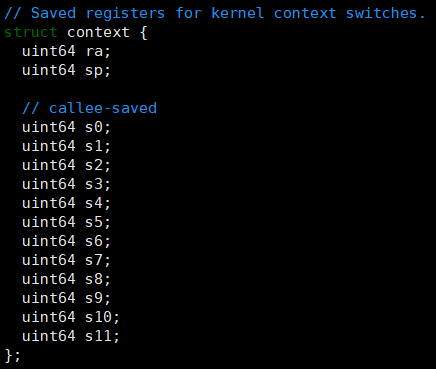
struct Context{
uint64 ra;
uint64 sp;
// callee-saved
uint64 s0;
uint64 s1;
uint64 s2;
uint64 s3;
uint64 s4;
uint64 s5;
uint64 s6;
uint64 s7;
uint64 s8;
uint64 s9;
uint64 s10;
uint64 s11;
};
struct thread {
char stack[STACK_SIZE]; /* the thread's stack */
int state; /* FREE, RUNNING, RUNNABLE */
struct Context ctx;
};3. thread_schedule
参考内核中的实现,这个函数和内核proc.c中的 scheduler() 的作用相同。
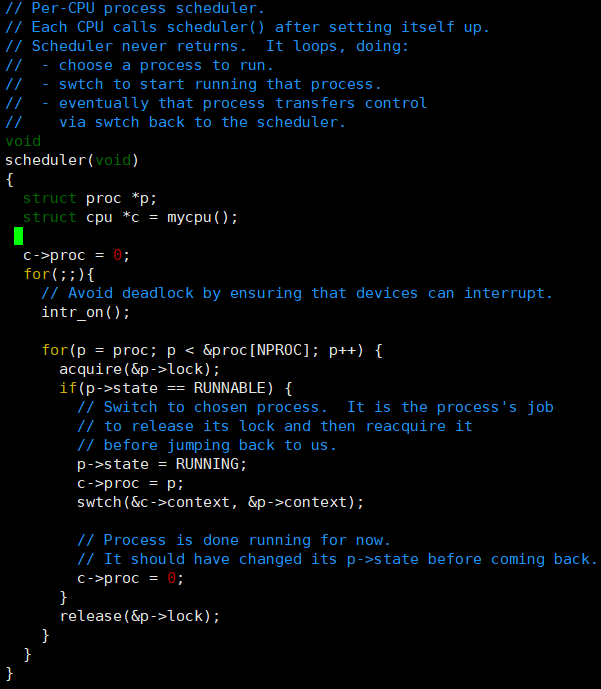
在 thread_schedule() 中,我们会需要调用 thread_switch() 来切换处理器的上下文。
观察原来thread_schedule函数的代码可以看到,最开始的循环找到了第一个为 RUNNABLE 的线程,然后把这个线程赋值到 next_thread。所以很明显,我们应该交换 current_thread 和 next_thread() 的上下文。
void thread_schedule(void)
{
struct thread *t, *next_thread;
/* Find another runnable thread. */
next_thread = 0;
t = current_thread + 1;
for(int i = 0; i < MAX_THREAD; i++){
if(t >= all_thread + MAX_THREAD)
t = all_thread;
if(t->state == RUNNABLE) {
next_thread = t;
break;
}
t = t + 1;
}
if (next_thread == 0) {
printf("thread_schedule: no runnable threads\n");
exit(-1);
}
if (current_thread != next_thread) { /* switch threads? */
next_thread->state = RUNNING;
t = current_thread;
current_thread = next_thread;
/* YOUR CODE HERE
* Invoke thread_switch to switch from t to next_thread:
* thread_switch(??, ??);
*/
thread_switch((uint64)&t->ctx, (uint64)¤t_thread->ctx);
} else
next_thread = 0;
}4. thread_create
实现这个函数主要需要思考如何设置 ra 和 sp 寄存器。因为用户进程一开始的时候是没有使用寄存器的,所以如何设置上下文中的其他寄存器是无所谓的。
首先,在 thread_create() 之后,如果我们调用了 thread_schedule() ,应该执行的是线程函数的第一个语句。所以可以这么设置 ra:
t->ctx.ra = (uint64) func;对于 sp,需要注意的是栈是从高地址到低地址增长的,那么 sp 应该被设置在栈的最高地址:
t->ctx.sp = (uint64) &t->stack + (STACK_SIZE - 1);那么这个 thread_create() 就写完了:
void
thread_create(void (*func)())
{
struct thread *t;
for (t = all_thread; t < all_thread + MAX_THREAD; t++) {
if (t->state == FREE) break;
}
t->state = RUNNABLE;
// YOUR CODE HERE
t->ctx.ra = (uint64) func;
t->ctx.sp = (uint64) &t->stack + (STACK_SIZE - 1);
}Using threads
任务描述:阅读一个散列表(哈希表)的程序,然后做一些更改,使得这个程序在多线程的环境下也可用。
尝试运行下提供的程序,只使用一个线程时一切正常。如果改成两个及以上就会出现某些在散列表中插入的键值对消失了。
为了解决这个问题,我们可以先看一遍这个散列表,找一找问题出现的地方。这个程序中,最关键的有三个函数 insert(),put() 和 get()。

insert的作用是创建一个结点e插入到p之后n之前。
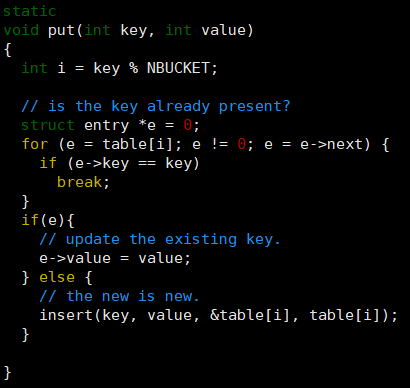
put用于将一个键值对插入哈希表中。如果键已经存在,更新其对应的值;如果键不存在,则插入一个新的键值对。
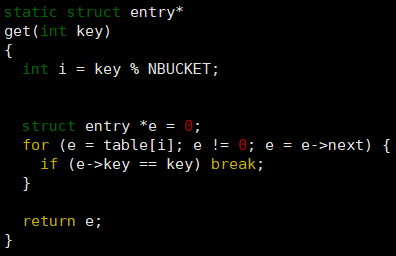
get根据键 key 查找并返回与之关联的键值对(即 struct entry 指针)。
在单线程的情况下这几个函数是没有问题的,但是多线程可能出现同时操作链表导致错误产生。
所以我们可以对于散列表中的每个链表都创建一个互斥锁,然后在 put() 和 get() 的开头和结尾加锁和解锁。
不在 insert() 里加锁是因为 insert() 都是 put() 调用的,已经在put()加锁了。

根据提示完善代码。
- 对于散列表中的每个链表都创建一个互斥锁:
pthread_mutex_t bkt_lock[NBUCKET];- 在
put()里添加锁:
static
void put(int key, int value)
{
int i = key % NBUCKET;
pthread_mutex_lock(&bkt_lock[i]);
// is the key already present?
struct entry *e = 0;
for (e = table[i]; e != 0; e = e->next) {
if (e->key == key)
break;
}
if(e){
// update the existing key.
e->value = value;
} else {
// the new is new.
insert(key, value, &table[i], table[i]);
}
pthread_mutex_unlock(&bkt_lock[i]);
}- 在
get()里添加锁:
static struct entry*
get(int key)
{
int i = key % NBUCKET;
pthread_mutex_lock(&bkt_lock[i]);
struct entry *e = 0;
for (e = table[i]; e != 0; e = e->next) {
if (e->key == key) break;
}
pthread_mutex_unlock(&bkt_lock[i]);
return e;
}Barrier
任务描述:实现同步屏障。
根据维基百科:
同步屏障(Barrier)是并行计算中的一种同步方法。对于一群进程或线程,程序中的一个同步屏障意味着任何线程/进程执行到此后必须等待,直到所有线程/进程都到达此点才可继续执行下文。
那么一个朴素的实现方法就是在一个线程到达屏障时把某个变量 +1,最后如果这个变量等于线程总数量,就可以执行了。
需要使用到的相关方法:

pthread_cond_wait()的作用是把线程放到等待列表中,然后解锁。
pthread_cond_broadcast()的作用是唤醒等待列表中的所有线程。
barrier()中要进行的操作是:
- 获得操作权后将等待的线程数+1
- 如果等待的线程数小于规定的线程数,把线程放入等待列表并释放操作权
- 如果等待的线程数达到规定的线程数,等待线程数清零,轮次+1,唤醒所有等待列表中的线程
- 释放操作权
然后就可以写出如下代码:
static void barrier()
{
// YOUR CODE HERE
//
// Block until all threads have called barrier() and
// then increment bstate.round.
//
pthread_mutex_lock(&bstate.barrier_mutex);
bstate.nthread++;
if(bstate.nthread < nthread){
pthread_cond_wait(&bstate.barrier_cond, &bstate.barrier_mutex);
} else {
bstate.nthread = 0;
bstate.round++;
pthread_cond_broadcast(&bstate.barrier_cond);
pthread_mutex_unlock(&bstate.barrier_mutex);
}
}The End
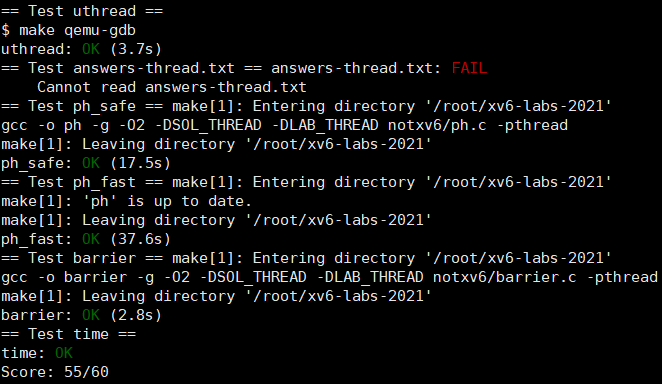
第一个实验是比较有难度的,既考察了对于源码的阅读,又考察了对于riscv底层的了解。(我自己做的话不知道要整多久
第二和第三个实验就简单多啦,和之前课堂上讲过PV操作差不多,理解上毫无障碍,但是对于题目所给的函数进行了什么操作有一点疑问。

